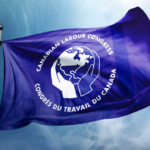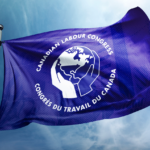
Health and Safety Conditions for Re-Opening Sectors of the Economy
As Canadian jurisdictions begin to open sectors of their economy it is important that working people have the protections they need to be able to do their jobs safely and get home to their loved ones at the end of every day without being injured, made ill or killed as a result of their work.
This is a monumental challenge in the era of COVID-19, but it is a challenge that we must meet. There are numerous Canadian and international examples of inadequate workplace health and safety protections leading to worker exposures and deaths and in some cases widespread community transmission of the virus. Workers are on the frontlines of this pandemic, and yet references to worker health and safety in public health guidance are rare and often insufficient.
As Canadian jurisdictions begin to re-start sectors of the economy, governments and employers must take steps to protect workers’ health and safety from COVID-19 exposure.
Before opening, employers must have in place a safety plan that keeps workers healthy and safe and ensures that workplaces don’t contribute to the spread of COVID-19 in the community. Specifically, employers must have an infection prevention and control plan, developed with the participation of workplace health and safety committees, or worker health and safety representatives. This plan must be in place before an employer is allowed to re-open. This plan must include a detailed health and safety response in the event of a workplace COVID-19 outbreak. Governments must have the capacity and commitment to enforcing occupational health and safety laws. If we are to avoid a dangerous second wave of COVID-19 infections, governments must also ramp up research and staffing capacity for rapid, effective COVID-19 testing and contact tracing to stem the spread of infections.
Health and Safety Rights at Work:
Canadian health and safety law is based on three basic rights at work, including:
- The right to know about the dangers in their workplace;
- The right to participate in decisions that affect their health and safety; and
- The right to refuse unsafe work.
Employers have a duty to remove workplace hazards that put the health and the lives of workers at risk.
These health and safety rights at work are enshrined in law in every jurisdiction in this country. Canada’s unions are clear: we will not relinquish those rights, risking workers’ lives as governments and employers make decisions to re-open sectors of the economy. We will not accept employers or our governments prioritising profits over people, putting workers in harm’s way without the appropriate safeguards and protective equipment. Employers must fulfill their duty to ensure a safe workplace, even in the face of this pandemic. Governments must protect a workers’ right to refuse unsafe work, and not ask workers to put their lives on the line without ensuring that every possible step is taken to allow them to do their jobs safely.
When a worker invokes their right to refuse unsafe work, they are deploying the last tool available to them to protect themselves from grave danger. It is not a step that anyone takes lightly. Accounts of government regulators ruling against all but a handful of refusals are extremely troubling. Reports indicating that there have been over 200 work refusals in Ontario with not a single one being upheld after the provincial government quietly set-up an internal committee to oversee the inspectors’ enforcement efforts, and inspectors reporting a chill on their ability to do their jobs is unacceptable to workers. Unions having to file complaints with the provincial labour relations board for employers to fulfill their health and safety obligations and the government to enforce the law is unacceptable. Workers deserve better than this. Ensuring that workers can exercise their basic health and safety right to safe work is non-negotiable.
Paid Sick Leave and Job Protection:
Although certain provinces have instituted COVID-19-specific measures to allow for quarantine or self-isolation, many of those sanctioned sick days are unpaid. No jurisdiction in Canada provides adequate, job-protected paid sick leave, leaving workers in the impossible situation of having to choose between paying the bills and protecting their health and that of their coworkers and community. Further, access to the protections that do exist often depends on where a person lives and what job they do. This is a recipe for a public health catastrophe.
Governments must ensure that every worker has access to at minimum, 14 paid, job-protected sick days so that they can take time off work when they are sick and need to quarantine or self-isolate.
Key to preventing a second, more severe wave of COVID-19 infections is ensuring that every worker in the country has access to sufficient paid, job-protected sick leave, regardless of where they live in Canada.
Worker Engagement:
Before re-opening, employers must make a COVID-19 safety plan that demonstrates how they will operate safely. This safety planning is key to ensuring that the workplace is effectively implementing COVID-19 controls and that the health and safety of workers and others aren’t put at risk as a result of their work arrangement.
It is important that employers consult with workers, their unions and their health and safety representatives about how to make sure these safety plans and COVID-19 controls will work. Engaging joint health and safety committees early on, and in an ongoing way is crucial to ensuring safe workplaces. Engaging workers, through their health and safety committees to participate in assessing COVID-19 related hazards and developing responses is an important part of good health and safety practice and must be included in workplace COVID-19 safety planning.
It is also the law. Canadian law and international labour conventions to which Canada is party require employers to involve workers in decisions that affect workplace health and safety. Employers cannot ignore workers’ concerns, making decisions unilaterally. Governments must commit to robust enforcement of these statutes.
Hazard Prevention and Control:
Hazard prevention planning and the hierarchy of controls are common workplace health and safety prevention tools. While there will be COVID-19 related hazards in the workplace for the foreseeable future, certainly until an effective vaccine is widely available, those hazards must be controlled to protect worker safety. Employers can play a role in preventing COVID-19 being transmitted to workers and the wider community by putting in controls to minimize the risk of infection, including:
- Supporting people with flu-like symptoms to self-isolate;
- Ensuring separation distances in the workplace;
- Disinfecting surfaces;
- Maintaining good hygiene, particularly good hand hygiene and cough/sneeze protocols.
Other controls to minimize exposure:
The workplace hazard prevention/control program and the hierarchy of controls must be deployed to reduce the likelihood of exposure. This includes:
- Eliminating hazards and Substituting higher risk procedures with lower risk activities, including allowing ongoing increased flexible working from home/telework arrangements to facilitate greater physical distancing within workplaces;
- Implementing engineering controls, including workplace design, equipment and ventilation system changes to reduce exposure;
- Using administrative controls such as staggered scheduling, controlling or restricting access to common spaces, more frequent cleaning/disinfecting of the workplace, preparing and training for emergency situations, as well as training and communication on COVID-related health and safety procedures and the use of personal protective equipment (PPE). Assessing work schedules and the potential need for additional health breaks to accommodate for fatigue related to the use of PPE, or increased workload related to COVID-19 protocols.
- Ensuring that workers have access to appropriate personal protective equipment (PPE) when the hazard cannot be eliminated through substitution, engineering or administrative controls. As it will be impossible to completely eliminate COVID-19 hazards in some workplace contexts through the use of substitution, engineering and administrative controls, an adequate supply of appropriate PPE will be critical to any strategy to re-open the economy. Workers will also require training and opportunities to practice in order to use PPE effectively. PPE must be provided at no cost to the worker.
The Precautionary Principle and Appropriate Personal Protective Equipment
As a new coronavirus, our knowledge of this virus, how it is transmitted and how infection presents with symptoms of COVID-19 is far from settled. As with any new hazard, a health and safety approach requires that we use the precautionary principle when making decisions on how to eliminate or control for this hazard. That means, implementing the higher level of protection, and not waiting for scientific certainty before taking precautions. Otherwise, individual workers are left to bear the burden of new hazards while our knowledge evolves. Just as knowledge about how COVID-19 symptoms presents in different populations is evolving, so is the evidence of how this virus is transmitted. There remains a lack of consensus on potential transmission pathways for COVID-19. Workers at elevated risk of exposure as a result of the populations they work with must be protected from all potential, not only the most common, routes of transmission.
Personal protective equipment is the last line of defence in the hierarchy of controls. If it fails, the worker is exposed to the hazard without any protection at all. This is why the precautionary principle is at the core of the labour movement’s argument for providing the higher levels of protection for workers.
Governments and employers would do well to remember the lessons of earlier outbreaks with this observation from the author of the SARS Commission Report:
“Scientific uncertainty and scientific debate can go on forever,” wrote Justice Archie Campbell at the conclusion of a public inquiry he led into Ontario’s handling of the SARS outbreak that killed dozens and sickened hundreds nearly two decades ago.
“What we need to do is to follow the precautionary approach that reasonable steps to reduce risk need not await scientific certainty … There is no longer any excuse for governments and hospitals to be caught off guard and no longer any excuse for health-care workers not to have the maximum level of protection through appropriate equipment and training.”
The Canadian Centre for Occupational Health and Safety (CCOHS) is making all of its pandemic planning and mental health resources available at no charge. Those resources can be found here.
CCOHS has also prepared a series of COVID-19 tip sheets for a variety of workplace sectors, which can be found at no cost here.
Worker Safety Data Collection and Transparency:
Some workers are at increased risk for workplace COVID-19 infections. Healthcare workers represent a disproportionately high percentage of those infected in Canada. Workers in food processing, transport, essential retail and all public-facing positions are also at increased risk for infection. To date, there is insufficient tracking and reporting on workplace exposures, illnesses and deaths of workers in these and other sectors. There is also a need for greater tracking and transparency on how this pandemic is affecting populations differently. We see in other countries that the number of exposures, illness and poorer outcomes varies significantly across equity-seeking groups and income levels. Canadian jurisdictions must collect and report on this data. Public health agencies can assist by supporting public exposure and infection registries to collect and report on this data. There is also a need for greater tracking and transparency on the state of supply of personal protective equipment (PPE). Fears of shortages without sufficient data lead to decisions that are putting frontline workers in harm’s way.
Protect Workers from Reprisals:
Just as the burden of the pandemic is not being experienced equally, neither will workers’ ability to return to the workplace as jurisdictions begin to re-open sectors of their economy. Workers with responsibilities to care for children or vulnerable adults, or who are at elevated risk for poor outcomes if they are exposed to the virus must be protected from reprisals if they cannot return to work when their workplace re-opens.
Employers must also accommodate, or implement specific controls to protect workers with elevated individual risk factors such as chronic medical conditions, pregnancy or older age when they return to the workplace.
Workers’ Compensation Systems:
Our first priority must be preventing worker exposures, illness and deaths from COVID-19. However, workers need to know that their workers’ compensation system will provide the benefits and supports that they need if they become ill as a result of their work. This is especially true in this pandemic. That means, broadening coverage to include all workers – including those in workplaces currently exempt from mandatory compensation coverage, as well as precarious and gig economy workers. It also means ensuring coverage for workers who must be quarantined or self-isolate as a result of a workplace exposure but may not yet have symptoms of COVID-19. It means streamlining adjudication processes for workers and protecting injured workers’ right to appeal decisions. It also means removing systemic financial incentives for employer claims suppression related to COVID-19 infections.
Finally, it also means moving to presumptive coverage for COVID-19 related illness, so that workers are not denied access to supports, waiting for their claim to be accepted. Certain international jurisdictions have implemented presumptive compensation coverage for some frontline workers, recognizing that streamlining the process for accessing supports will result in better health outcomes and safer return to work pathways for workers at higher risk of COVID-19 infection. We are encouraged to see that WorkSafe BC has begun the process to include COVID-19 for presumptive compensation coverage. Other jurisdictions must move in the same direction, to ensure that workers have the supports and compensation they need when their work makes them sick.







